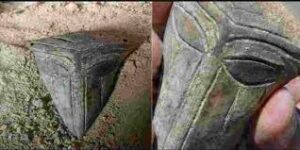Introduction
Recently, archaeologists in the Solnitsata settlement, near Provadia in northeastern Bulgaria, uncovered a mysterious mask dating back about 6,000 years. This mask, believed to belong to the Eneolithic period (around 4000 BC), has unique features blending human and animal characteristics, giving it an alien-like appearance often found in science fiction. So what makes this mask so special? And could there be hidden symbolic meanings behind it yet to be uncovered?
A Strange Mask from the Eneolithic Era
Origins and Key Features
The mask was excavated at “The Salt Pit,” Europe’s oldest known city, under the guidance of Professor Vasil Nikolov. Solnitsata is renowned as one of the continent’s oldest settlements, famous for its salt mining and trade activities dating back millennia. This mask may have belonged to someone important within that ancient society and likely holds deep symbolic significance.

Unique Structure and Design
Shape and Physical Features
The mask has a triangular shape with a protruding front and a concave back. The upper corners of the mask feature two short projections, possibly representing stylized “ears.” On its surface, finely carved details include distinct eyebrows, a sleek nose, and large oval eyes.
The Design’s Absence of a Mouth
One of the most intriguing aspects of the mask is its lack of a mouth. This feature could symbolize silence, mystery, or even a sense of the sacred that ancient people sought to convey. Some theories suggest it may represent the ancient attempt to depict the likeness of gods or other mystical entities.
Potential Functions of the Mask
The small holes along the mask’s edges indicate that it may have been secured with a thread to cover the face. However, researchers are also considering the possibility that it served as an amulet, worn on the chest as a form of sun worship. This reflects the deep religious reverence for natural elements, especially the sun, that was common in ancient cultures.

Cultural and Symbolic Aspects
Divine Symbols and Sun Worship
Many ancient cultures revered the sun as a symbol of life, light, and power. If this mask indeed served as a symbol of sun worship, it would offer strong evidence of the profound spirituality of the Solnitsata people. Details like the “ears” and large eyes could represent communication with deities or a connection with the otherworldly, mirroring the “alien” appearance noted by Professor Nikolov.
Celebrating Status and Power
Given the detail and craftsmanship of the mask, it is likely that it was a decorative item worn by someone of high status, symbolizing power and importance. In many cultures, masks also served as a way for wearers to connect with supernatural beings, acting as a bridge between humans and the divine.
The Hidden Meanings Behind the Mask
Metaphors for Belief and Spirituality
The mask is not only an archaeological object but also a window into the beliefs and spirituality of ancient people. The absence of a mouth could symbolize silence before supernatural forces or express reverence and sanctity. This mask may carry a message from our ancestors: some things cannot be expressed in words.
The Alien Symbol Theory
With its “alien-like” appearance, could it be that ancient people held advanced knowledge of the world or had a symbolic representation of “foreign beings”? Some scholars suggest that the mask’s large eyes and triangular shape might point to mystical entities that ancient people believed in.

Conclusion
The 6,000-year-old mask from Solnitsata is a surprising and mysterious discovery. From its mouthless design to details that evoke the divine or mystical entities, this artifact is a testament to the rich spirituality, culture, and artistry of ancient people. It raises questions about origin and symbolic meaning that modern science has yet to fully unravel. This mask is not merely an archaeological artifact; it is a bridge connecting us with the beliefs and spiritual world of ancient civilizations.
